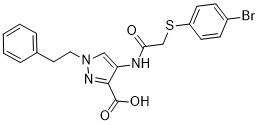Physicochemical Properties
| Molecular Formula | C20H18BRN3O3S |
| Molecular Weight | 460.3442 |
| Exact Mass | 459.025 |
| Elemental Analysis | C, 52.18; H, 3.94; Br, 17.36; N, 9.13; O, 10.43; S, 6.96 |
| CAS # | 1021497-97-1 |
| Related CAS # | 1021497-97-1 |
| PubChem CID | 25009726 |
| Appearance | White to off-white solid powder |
| LogP | 4.6 |
| Hydrogen Bond Donor Count | 2 |
| Hydrogen Bond Acceptor Count | 5 |
| Rotatable Bond Count | 8 |
| Heavy Atom Count | 28 |
| Complexity | 525 |
| Defined Atom Stereocenter Count | 0 |
| InChi Key | ZRLJEHIUGYTTSZ-UHFFFAOYSA-N |
| InChi Code | InChI=1S/C20H18BrN3O3S/c21-15-6-8-16(9-7-15)28-13-18(25)22-17-12-24(23-19(17)20(26)27)11-10-14-4-2-1-3-5-14/h1-9,12H,10-11,13H2,(H,22,25)(H,26,27) |
| Chemical Name | 4-[[2-(4-bromophenyl)sulfanylacetyl]amino]-1-(2-phenylethyl)pyrazole-3-carboxylic acid |
| Synonyms | KR 33494; KR-33494; KR33494 |
| HS Tariff Code | 2934.99.9001 |
| Storage |
Powder-20°C 3 years 4°C 2 years In solvent -80°C 6 months -20°C 1 month |
| Shipping Condition | Room temperature (This product is stable at ambient temperature for a few days during ordinary shipping and time spent in Customs) |
Biological Activity
| Targets | Fas |
| ln Vivo | In both sexes, body weight fluctuations were not influenced by KR-33493 at any dosage. No test article-related alterations were observed in hematology, serum chemistry, or urinalysis in any treatment group, regardless of gender, in rats given KR-33493 for four weeks. During a two-week period, dogs administered KR-33493 showed significantly increased male red blood cell count (RBC) values at the 1000 mg/kg/day dose compared to the control group (6.96±0.323 vs. 6.12±0.418). After the dosage period ended, red blood cell alterations did, however, reverse. The fact that there were no appreciable variations in dose-normalized AUClast among the groups suggests that linear kinetics are in charge of KR-33493 [1]. |
| References |
[1]. Subacute toxicity evaluation of KR-33493, FAF1 inhibitor for a new anti-parkinson's disease agent, after oral administration in rats and dogs. Regul Toxicol Pharmacol. 2016 Nov;81:387-396. |
Solubility Data
| Solubility (In Vitro) | DMSO: ≥ 31 mg/mL (~67.3 mM) |
| Solubility (In Vivo) |
Solubility in Formulation 1: ≥ 2.5 mg/mL (5.43 mM) (saturation unknown) in 10% DMSO + 40% PEG300 + 5% Tween80 + 45% Saline (add these co-solvents sequentially from left to right, and one by one), clear solution. For example, if 1 mL of working solution is to be prepared, you can add 100 μL of 25.0 mg/mL clear DMSO stock solution to 400 μL PEG300 and mix evenly; then add 50 μL Tween-80 to the above solution and mix evenly; then add 450 μL normal saline to adjust the volume to 1 mL. Preparation of saline: Dissolve 0.9 g of sodium chloride in 100 mL ddH₂ O to obtain a clear solution. Solubility in Formulation 2: ≥ 2.5 mg/mL (5.43 mM) (saturation unknown) in 10% DMSO + 90% Corn Oil (add these co-solvents sequentially from left to right, and one by one), clear solution. For example, if 1 mL of working solution is to be prepared, you can add 100 μL of 25.0 mg/mL clear DMSO stock solution to 900 μL of corn oil and mix evenly. (Please use freshly prepared in vivo formulations for optimal results.) |
| Preparing Stock Solutions | 1 mg | 5 mg | 10 mg | |
| 1 mM | 2.1723 mL | 10.8615 mL | 21.7231 mL | |
| 5 mM | 0.4345 mL | 2.1723 mL | 4.3446 mL | |
| 10 mM | 0.2172 mL | 1.0862 mL | 2.1723 mL |
